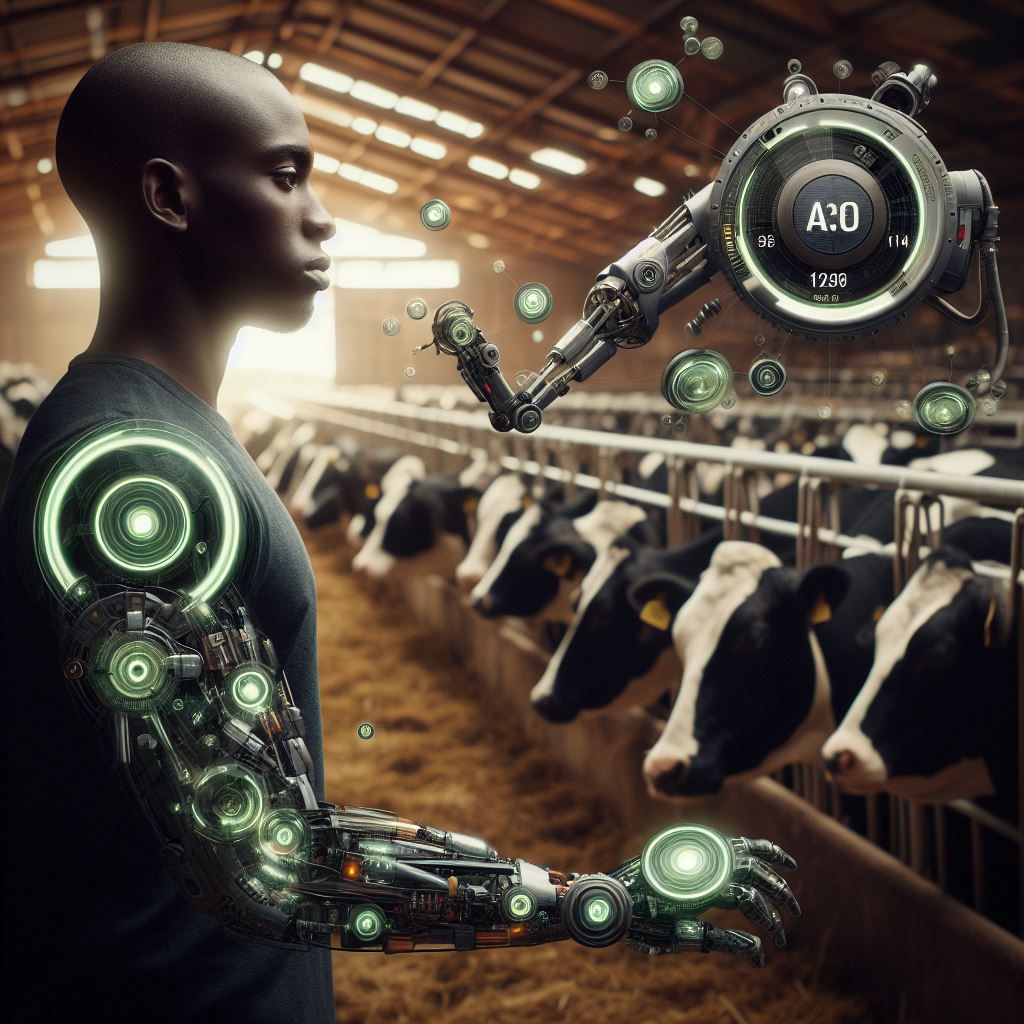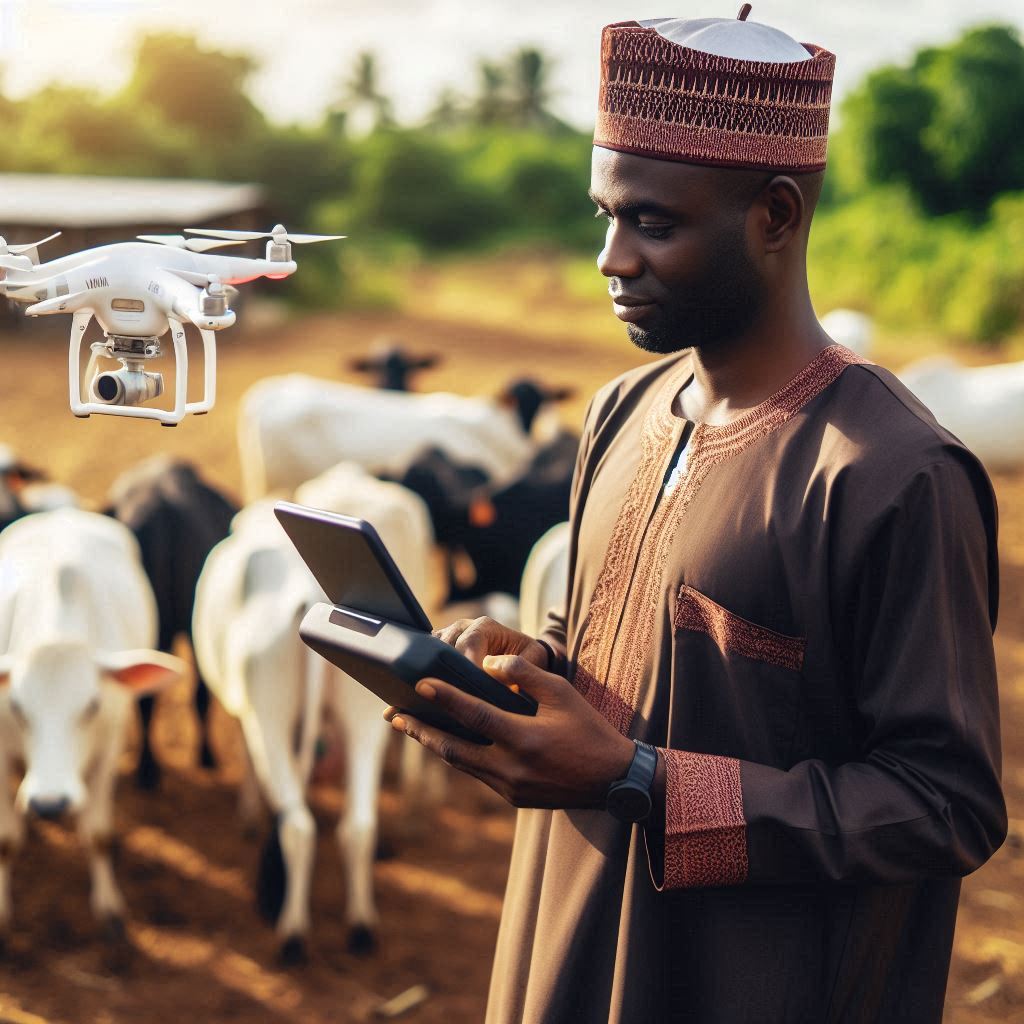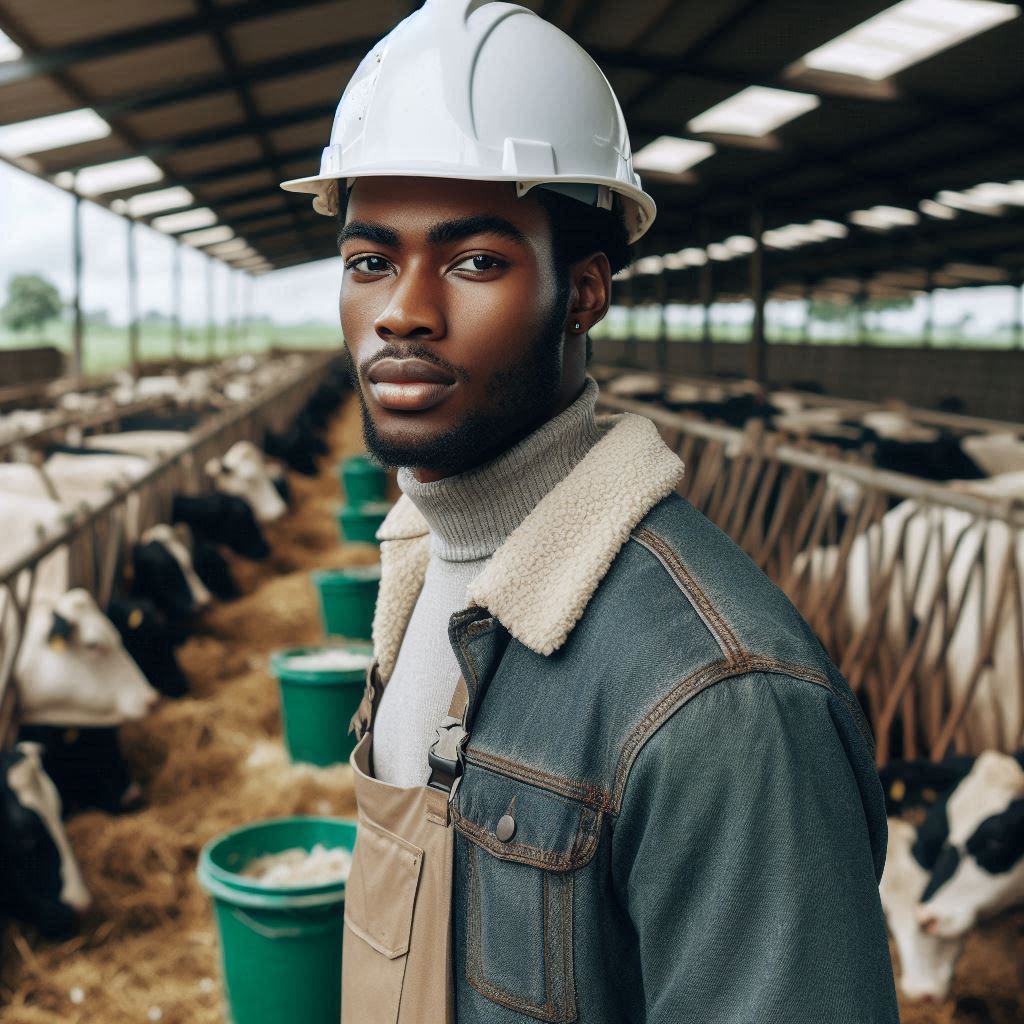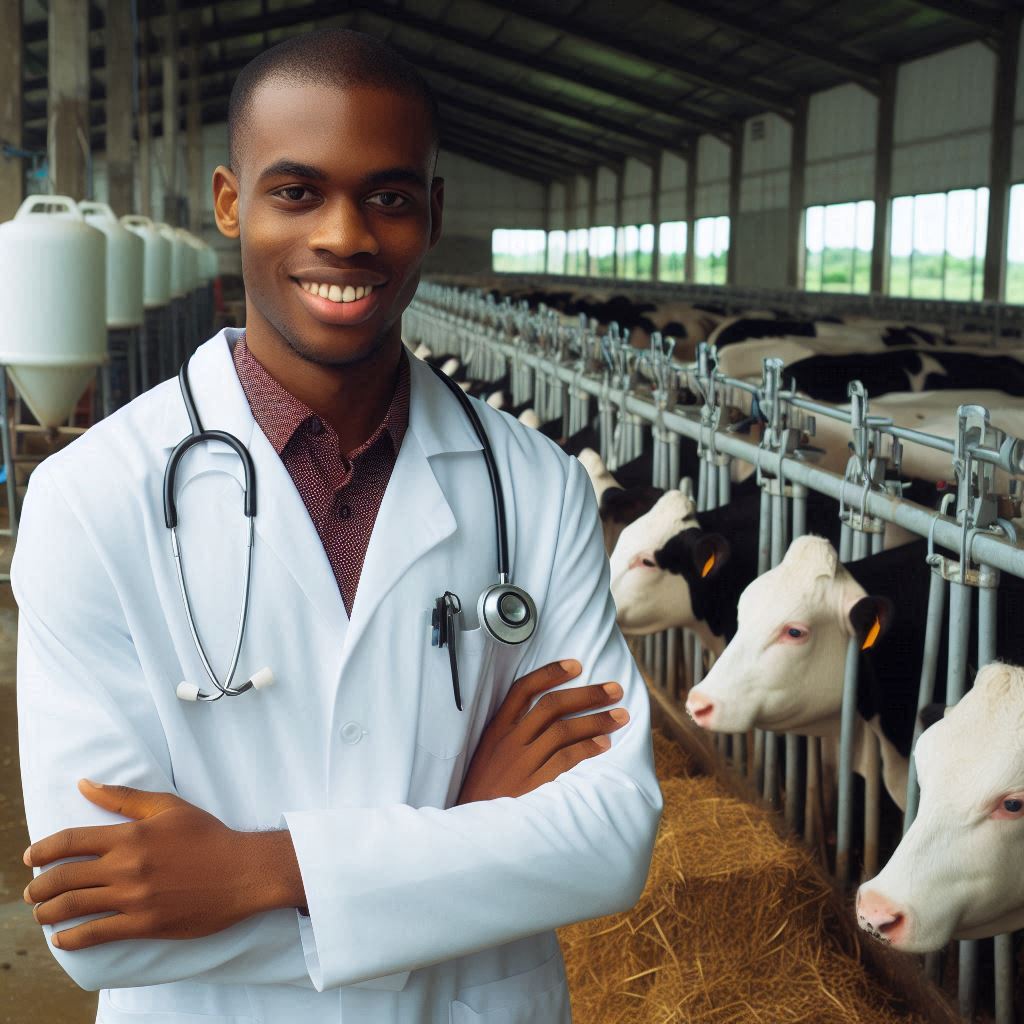Introduction
AI is transforming livestock production by enhancing efficiency and productivity.
Advanced technologies monitor animal health and optimize feeding practices.
AI systems detect early signs of illness, enabling prompt intervention that reduces mortality rates.
By constantly monitoring animal behaviors and vital signs, AI can identify issues that might be missed by human observation alone.
Additionally, AI analyzes dietary needs, ensuring precise feeding that improves growth and reduces waste.
Automated feeding systems use AI to deliver the right amount of nutrients to each animal based on their individual needs, leading to better overall health and faster growth rates.
This precision feeding not only enhances animal well-being but also lowers costs by minimizing feed wastage.
In summary, AI revolutionizes livestock production, offering numerous benefits for farmers.
These technologies lead to healthier animals, efficient resource use, and greater productivity.
By adopting AI, farmers can enhance their operations, reduce costs, and promote sustainable practices.
The integration of AI into livestock production represents a significant advancement in agricultural technology, paving the way for a more efficient and sustainable future in farming.
AI is not just a tool for improvement but a transformative force that is reshaping the entire landscape of livestock production.
Benefits include improved efficiency, better animal health monitoring, and increased productivity in farming.
Benefits of AI in Livestock Production
Increased Efficiency in Breeding and Genetics
AI technologies have revolutionized the way livestock breeding and genetic selection are carried out.
By utilizing big data and artificial intelligence algorithms, farmers can analyze vast amounts of genetic information to make informed decisions about breeding.
This results in a more efficient and targeted breeding process, leading to the development of healthier, more productive livestock.o
Improved Animal Health Monitoring
AI-powered systems enable real-time monitoring of livestock health, allowing farmers to detect any potential health issues early on.
By analyzing data from various sensors and monitoring devices, AI can provide insights into the overall health status of individual animals and the entire herd.
This proactive approach helps in preventing diseases and improving animal welfare.
Enhanced Farm Management and Decision-making
Artificial intelligence tools offer farmers valuable insights into farm operations, including data on feed efficiency, environmental conditions, and animal behavior.
This data-driven approach enables farmers to optimize their management practices, improve resource utilization, and make informed decisions to enhance overall farm productivity.
AI can also help in forecasting market trends and adjusting production accordingly.
Predictive Analytics for Better Productivity
AI algorithms can analyze historical data to predict future trends and outcomes in livestock production.
By leveraging predictive analytics, farmers can anticipate potential challenges or opportunities and adjust their strategies accordingly.
This proactive approach helps in maximizing productivity, reducing risks, and ensuring sustainable livestock production practices.
In general, AI is revolutionizing livestock production by increasing efficiency, improving animal health monitoring, enhancing farm management practices, and enabling predictive analytics for better productivity.
These advancements not only benefit farmers but also contribute to the overall sustainability and profitability of the livestock industry.
Read: Traditional vs Modern Horticulture in Nigeria
Examples of AI Implementation in Livestock Production
AI is revolutionizing livestock production through innovative applications that enhance efficiency and productivity. These implementations demonstrate how technology can transform traditional farming methods.
Use of Sensors for Monitoring Animal Behavior and Health
Sensors play a crucial role in modern livestock management.
They continuously monitor animal behavior and health.
Wearable sensors track vital signs like heart rate, temperature, and activity levels.
AI analyzes this data to detect early signs of illness or stress.
This real-time monitoring allows for prompt intervention, reducing mortality rates and improving overall animal welfare.
By providing detailed insights into each animal’s health, farmers can make informed decisions to enhance care and productivity.
Automated Feeding and Milking Systems
Automated feeding and milking systems have revolutionized dairy and livestock farming.
AI-driven feeders deliver precise amounts of nutrients tailored to each animal’s needs.
This precision feeding improves growth rates and reduces feed waste.
Milking robots automate the milking process, ensuring consistent quality and hygiene.
These systems monitor milk yield and composition, helping farmers optimize their herd’s production.
Automation also frees farmers from labor-intensive tasks, allowing them to focus on other aspects of farm management.
RFID Technology for Tracking and Managing Livestock
RFID technology efficiently tracks and manages livestock. Farmers attach RFID tags to animals, storing age, health records, and breeding history.
AI systems use this data to manage herd health and productivity effectively.
Farmers can quickly identify and isolate sick animals, preventing the spread of disease.
RFID technology also streamlines record-keeping, making it easier to monitor each animal’s lifecycle.
This comprehensive tracking system enhances operational efficiency and improves herd management.
Drone Technology for Monitoring and Managing Large Farms
Drones equipped with AI technology provide a bird’s-eye view of large farms.
They monitor livestock, assess pasture conditions, and detect potential issues.
Drones can cover vast areas quickly, providing detailed imagery and data.
AI analyzes this information to identify areas that need attention, such as overgrazed pastures or water shortages.
Drones also help in locating and managing livestock in large, open fields.
This technology reduces the time and labor required for farm inspections and enhances overall farm management.
Generally, AI’s implementation in livestock production is transforming the industry.
Sensors monitor animal health, automated systems streamline feeding and milking, RFID tags improve tracking, and drones enhance farm management.
These technologies not only increase efficiency but also improve animal welfare and farm sustainability.
By adopting AI, farmers can optimize their operations and ensure a more productive and sustainable future for livestock farming.
The integration of AI into livestock production represents a significant advancement in agricultural technology, paving the way for more efficient and sustainable farming practices.
Read: Field Work & Practical Training in Nigerian Forestry Schools
Challenges and Limitations of AI in Livestock Production
Initial Costs of Implementing AI Technology
The initial costs of implementing AI technology can be prohibitively high for many farmers.
Purchasing advanced equipment and setting up AI systems requires a substantial financial investment.
Small-scale farmers may find it challenging to afford these technologies.
The high cost of AI can limit its adoption, particularly in developing regions where funding and resources are scarce.
Data Privacy and Security Concerns
AI systems in livestock production collect and analyze vast amounts of data.
This data includes sensitive information about farm operations and animal health.
Data privacy and security concerns arise from the risk of unauthorized access and data breaches.
Protecting this data is crucial to maintaining trust and ensuring the integrity of farming operations.
Farmers must implement robust cybersecurity measures to safeguard their information.
Need for Specialized Training and Skills
Managing AI systems requires specialized training and skills that many farmers currently lack.
Understanding how to operate, maintain, and troubleshoot AI technologies is essential for their effective use.
Farmers need to invest in education and training programs to acquire these skills.
This need for specialized knowledge can be a barrier to AI adoption, particularly for older farmers or those with limited access to training resources.
Potential Job Displacement for Farm Workers
The automation of tasks through AI has the potential to displace farm workers.
Automated systems can perform feeding, cleaning, and monitoring tasks traditionally done by human labor.
This shift can lead to job losses and reduced employment opportunities in the agricultural sector.
It is crucial to consider the social impact of AI and find ways to retrain and redeploy displaced workers.
In fact, while AI offers transformative benefits for livestock production, addressing its challenges and limitations is essential.
By investing in cost-effective solutions, ensuring data security, providing training, and considering the social impacts, the agricultural sector can harness AI’s potential.
Embracing AI in a responsible and inclusive manner will lead to a more efficient, productive, and sustainable future for livestock farming.
Read: Overview of Horticulture in Nigeria

Future Prospects of AI in Livestock Production
Advancements in AI Technology
AI technology in livestock production is continuously evolving, leading to increased efficiency and productivity.
Advancements in machine learning algorithms have enabled AI systems to analyze data and make real-time decisions.
AI-powered sensors and monitoring devices can track the health and behavior of livestock, optimizing their well-being.
Genetic algorithms are used to improve breeding programs, resulting in healthier and higher-yielding livestock.
Integration with Other Agricultural Practices:
AI can be integrated with precision agriculture techniques to optimize resource management and reduce waste.
Data collected from AI systems can inform decisions on feed management, disease control, and breeding strategies.
By combining AI with IoT devices, farmers can remotely monitor livestock and make informed decisions based on real-time data.
AI can also be used to automate tasks such as feeding, milking, and monitoring, saving time and labor costs.
Sustainable Farming Practices:
AI offers the potential to promote sustainable farming practices by reducing the environmental impact of livestock production.
By optimizing resource use and minimizing waste, AI systems can help farmers operate more efficiently and responsibly.
Predictive analytics powered by AI can help farmers anticipate and prevent issues that may impact livestock health or production.
AI can assist in monitoring soil health, water usage, and other environmental factors to ensure long-term sustainability.
Government Policies and AI Adoption
Government support is crucial in promoting the adoption of AI technology in agriculture, including livestock production.
Policies that offer incentives, grants, and subsidies can encourage farmers to invest in AI solutions for their operations.
Regulations that ensure data privacy and security are essential to build trust in AI systems among farmers and consumers.
Collaboration between government agencies, research institutions, and industry stakeholders is key to driving innovation and adoption of AI in livestock production.
Read: Hydroponics in Nigerian Horticulture
Conclusion
In this blog post, we explored the transformative potential of AI in livestock production. AI offers numerous benefits and poses some challenges. Let’s recap these key points.
Benefits of AI in Livestock Production
AI significantly enhances livestock health monitoring. It detects early signs of illness, allowing for prompt intervention and reducing mortality rates.
AI also optimizes feeding practices by analyzing dietary needs, ensuring precise feeding that improves growth and minimizes waste.
AI revolutionizes breeding by selecting the best pairs.
This results in healthier and more productive offspring. Additionally, AI optimizes resource use, promoting sustainable farming practices. Smart sensors and data analytics help manage water, feed, and land more effectively.
Transform Your Career with Expert Guidance
Get personalized mentorship consulting that’s tailored to your unique path. Our expert advice is actionable and exclusive.
Get StartedAutomation through AI reduces labor costs and increases overall farm productivity.
Robots and automated systems perform tasks such as feeding, cleaning, and health monitoring. This frees up farmers to focus on strategic aspects of farm management.
Challenges of Using AI in Livestock Production
Despite its many benefits, AI in livestock production faces challenges.
The high cost of AI technology can be a barrier for many farmers. Initial investment and maintenance costs may deter small-scale farmers from adopting AI solutions.
Technical knowledge and expertise are required to implement and manage AI systems effectively. Farmers need training and support to integrate AI into their operations.
Data privacy and security concerns also arise with the use of AI. Ensuring that sensitive data is protected is crucial.
The Transformative Potential of AI in Modern Farming
AI has the potential to revolutionize modern farming. By enhancing efficiency and productivity, AI can address some of the most pressing challenges in agriculture. The ability to monitor animal health, optimize feeding, and improve breeding practices makes AI an invaluable tool.
AI also promotes sustainability in agriculture. By optimizing resource use, AI reduces the environmental impact of farming. This is crucial for creating a more sustainable and eco-friendly agricultural sector.
AI-driven automation increases farm productivity and allows farmers to manage larger herds more efficiently.
Encouraging Further Research and Investment
To fully realize the benefits of AI in agriculture, further research and investment are necessary.
Continued innovation in AI technology will lead to more affordable and accessible solutions for farmers.
Governments, academic institutions, and private companies should collaborate to advance AI research in agriculture.
Investing in training and education is also essential.
Farmers need the knowledge and skills to implement and manage AI systems effectively.
Providing support and resources will help farmers integrate AI into their operations successfully.
In the end, AI offers transformative potential for livestock production.
By enhancing efficiency, productivity, and sustainability, AI can revolutionize modern farming.
Despite some challenges, the benefits of AI far outweigh the drawbacks.
Continued research and investment in AI technologies for agriculture will pave the way for a more efficient, sustainable, and productive future in farming.




